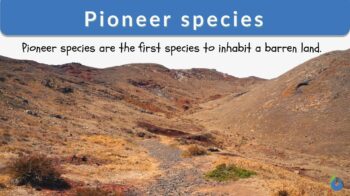
Pioneer species
n., plural: pioneer species
[ˌpaɪəˈnɪə ˈspiːsiːz]
Definition: first ones to colonize an ecosystem
Table of Contents
You might have come across news of some barren lands turning into luscious grasslands or forests after decades? Or you might have read it sometime in some Science magazine that a burnt forest was reclaimed by years of effort? Or maybe you would have personally observed a landslide-ridden hill station now harboring various species of plants, birds, insects, and animals… Can you think of a reason how such nutrient-depleted, barren, and impoverished lands turn into species-rich jungles over years? The answer to it is — “Pioneer species”!
Pioneer Species Definition
In Biology, the definition of pioneer species goes by this:
“those species which initiate the development of an ecological community in an area with currently no life form’s existence”
The areas that are totally barren, devoid of any nutrients, and uninhabitable provide bleak (to none) chances for any life form to ever establish in them. But there comes the hardy, photosynthetic, ubiquitous, fast-reproducing, orthodox-seeded, with high dispersibility rates, smaller life cycles, and high tolerance pioneer community to rescue… So, if someone asks us to define pioneer species, we can easily provide them with their general features and explain how the trajectory of ecological succession is shaped. Let’s get to know the features of pioneer species in the next section.
Features of Pioneer Species
- Hardy in nature
Pioneer species can tolerate and trade through any type of prevailing harsh environmental conditions. - Seeds: orthodox and easy to germinate
Pioneer species possess orthodox seeds meaning “seeds with <5% total moisture content and still viable and possessing exceptional longevity”. This quality helps pioneer species to propagate even after years of dormancy. They easily tolerate desiccation and can give rise to new plants after germination. Low moisture content doesn’t take a toll on these seeds. - Seed Germination: Light-induced
Pioneer species’ seeds are generally “photoblastic” in nature; they germinate by the stimulation of light. Usually, any seed germinates when it’s provided with optimal conditions of moisture, nutrients and other environmental factors but these seeds don’t have much to demand in barren lands. The sole requirement for their germination has evolved to be just “stimulation by light”. - Life cycle: Short
Any biological body is born with nature’s ultimate aim of “continuation of species”. Since barren lands provide little options for any species to have a pleasant time for a long, pioneer species have evolved to have a short life cycle. This is an indication of an early reproductive chapter in their lives. By whichever means they produce the progeny (sexual or asexual), reproductive maturity happens really fast in pioneer species! - Pollination and Seed Dispersal: Both via wind
Since an inhospitable environment isn’t good for any species, it is the same for pollinators as well (whether they would be birds, insects, bats, or animals). The only course of action is wind pollination. Most of the sexually reproducing pioneer species, for whom pollination is a vital step for fertilization of gametes, are pollinated by wind. Additionally, even the dispersal of their seeds is via wind. - Rates of seed production and dispersal: High
Seeds of pioneer species are highly viable, produced in a geometric fashion (exceptionally large numbers), and possess very high dispersal rates. In order to colonize a nutrient-devoid land, such dispersal rates are mandatory. - Propagule size: Small
Small propagule size aids in easy dispersal and realization of succession goals. Also, small seed or propagule size increases the chances of germination as these can get “trapped” in small crevices, holes, and traps during hostile times. - Wide Range: Both Ecological and Geographical
This makes the distribution more ubiquitous and aids in primary succession in areas affected by varied factors. - Major Mode of Reproduction: Asexual>Sexual
Because the sexual mode of reproduction is more energy-demanding and time-consuming, it isn’t really a suitable choice for pioneer species. Although species with sexual mode are also recorded. Conversely, the asexual mode is more prevalent due to the advantages associated with it.
Look at our forum discussion – Sexual vs Asexual Reproduction differences
Pioneer Species and Ecological Succession
In order to develop conceptual clarity on pioneer species, it is imperative to understand the concept of ecological systems, the development of ecological communities, and ecological successions.
Ecological systems entail the biological interactions between the different elements of the natural system and their varied interrelations. The way this system is built determines how an ecological system will function, its basic requirements, sustainability, and prosperity.
An ecological community is area-specific and depends on how “commonly” some species occur together. The species share the same environmental factors and similar lack/abundance of resources. How they influence each other determines the balance of that community.
Ecological succession encompasses all factors, processes, and interrelationships within a community governing its evolution over time. It deals basically with the “structural” change of a biological community over the evolutionary timescale. Every physical, chemical, and the biological entity is subject to change with time and this is what ecological succession describes: “changes in community skeleton”– how different species evolve, how the evolution of one affects the other, how coevolution takes place, how organisms slowly adapt to thrive in environmental harshness!
There are 2 types of ecological successions:
Primary succession
Primary succession is the succession that takes place in an area where no other organism has previously lived, thrived, and reproduced. This is where only pioneer organisms- specifically “only pioneer plants” can lead to the creation of a hospitable environment.
Characteristics of any pioneer organism to be capable to make primary succession happen:
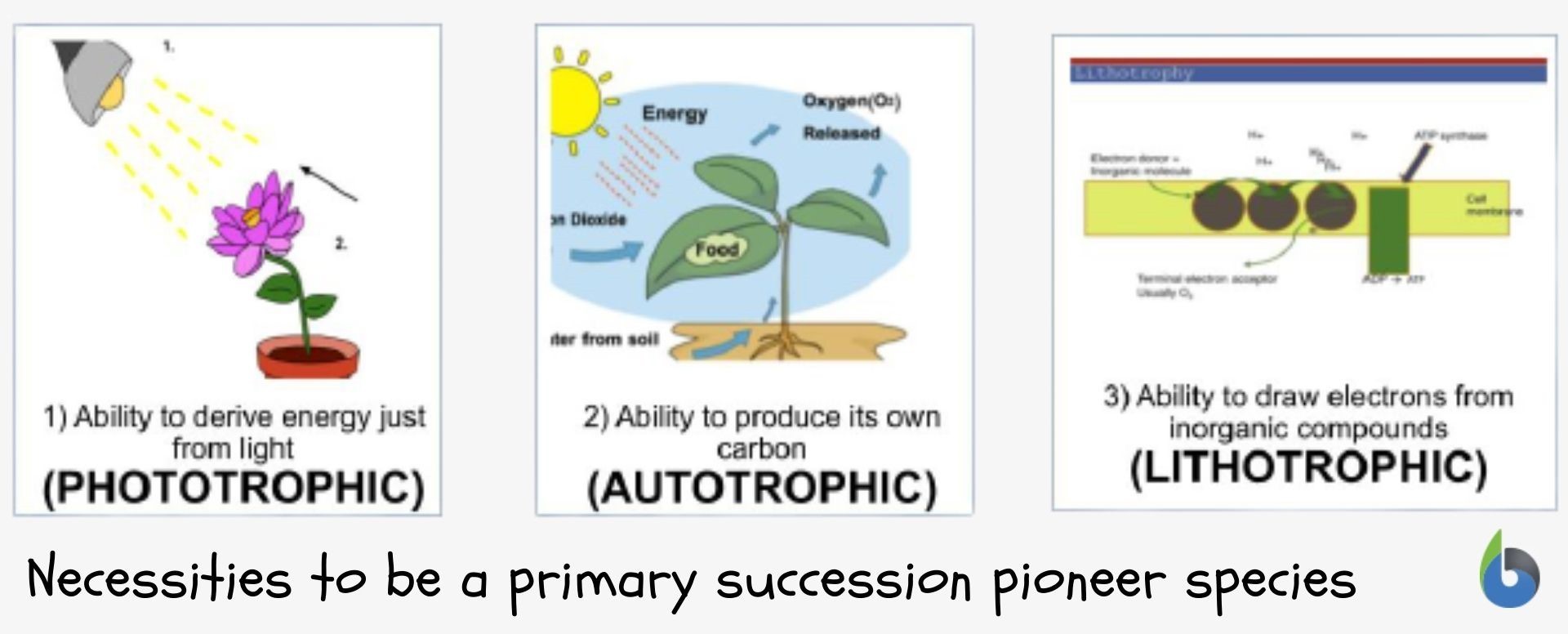
Reasons for points 1-3:
- Any barren land would be devoid of pre-existing organic compounds, so no oxidation of organic compounds is possible for energy needs.
- Any barren land won’t be home to pre-existing autotrophs, so the heterotrophic mode of carbon derivation is plainly stripped off.
- Any barren land would definitely have no possible organic source of electrons (even the possibility of inorganic sources is bleak…but if some minute possibility is counted in, it’s JUST an inorganic source SOLELY!)
Therefore, the pioneer species in primary succession has to necessarily be a plant — a photo-auto-lithotroph. They colonize the bare substrates (no soil) and develop ecological communities thereafter.
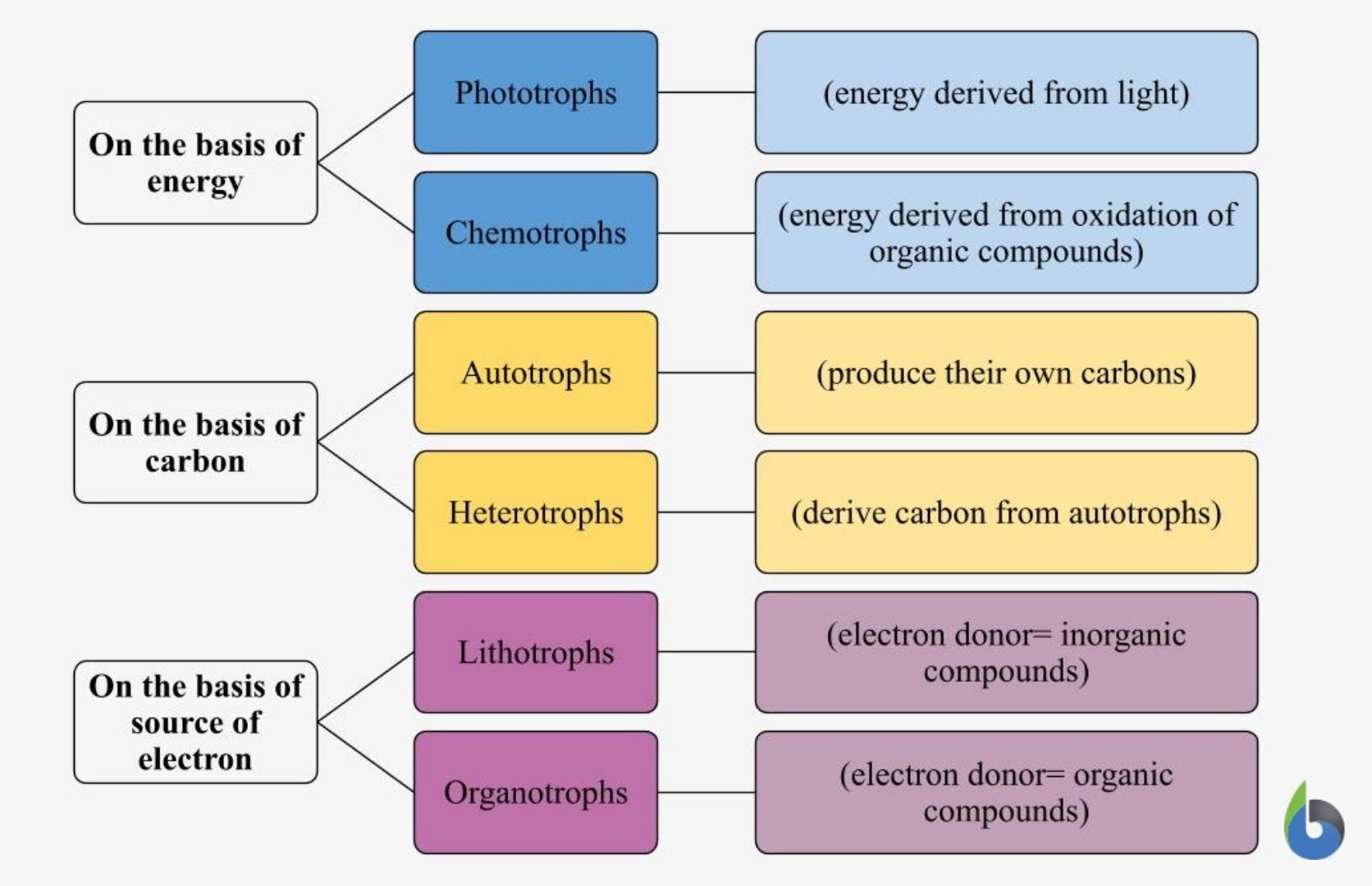
Primary succession examples:
Only plants and a particular class of algae — “blue green algae/Cyanobacteria” — count as photo-auto-lithotrophs. Thus, examples of pioneer species responsible for primary succession are limited to them. Areas affected by major landslides, fires, volcanic eruptions, or flooding suffer apocalyptic habitat destruction. Such areas witness even erosion of the topsoil and the layers beneath. In such lands, no energy/carbon/electron source is left behind that can support life other than photo-auto-litho-trophic. Another interesting point to note here is the “essence of a limiting resource – NITROGEN”. Hence, a lot of these pioneers are nitrogen-fixing.
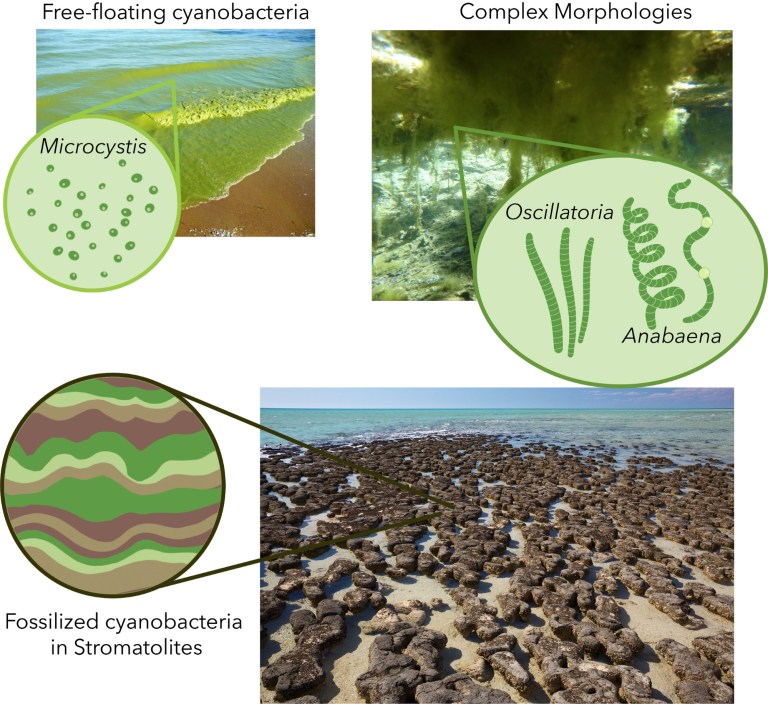
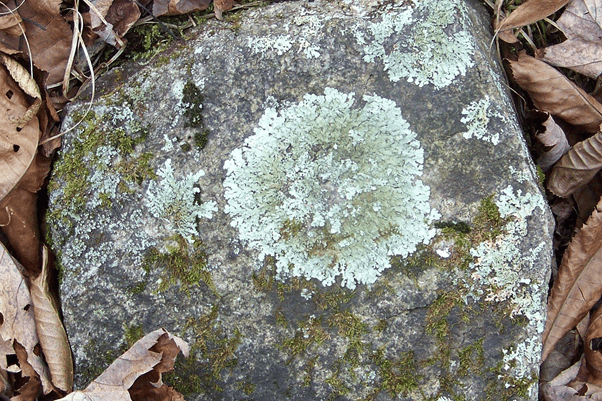
If you take a glance at the illustration below, you’ll better understand some specificities associated with each pioneer species and a very definitive role in primary succession according to the degree of inhospitality/destruction to a given site:
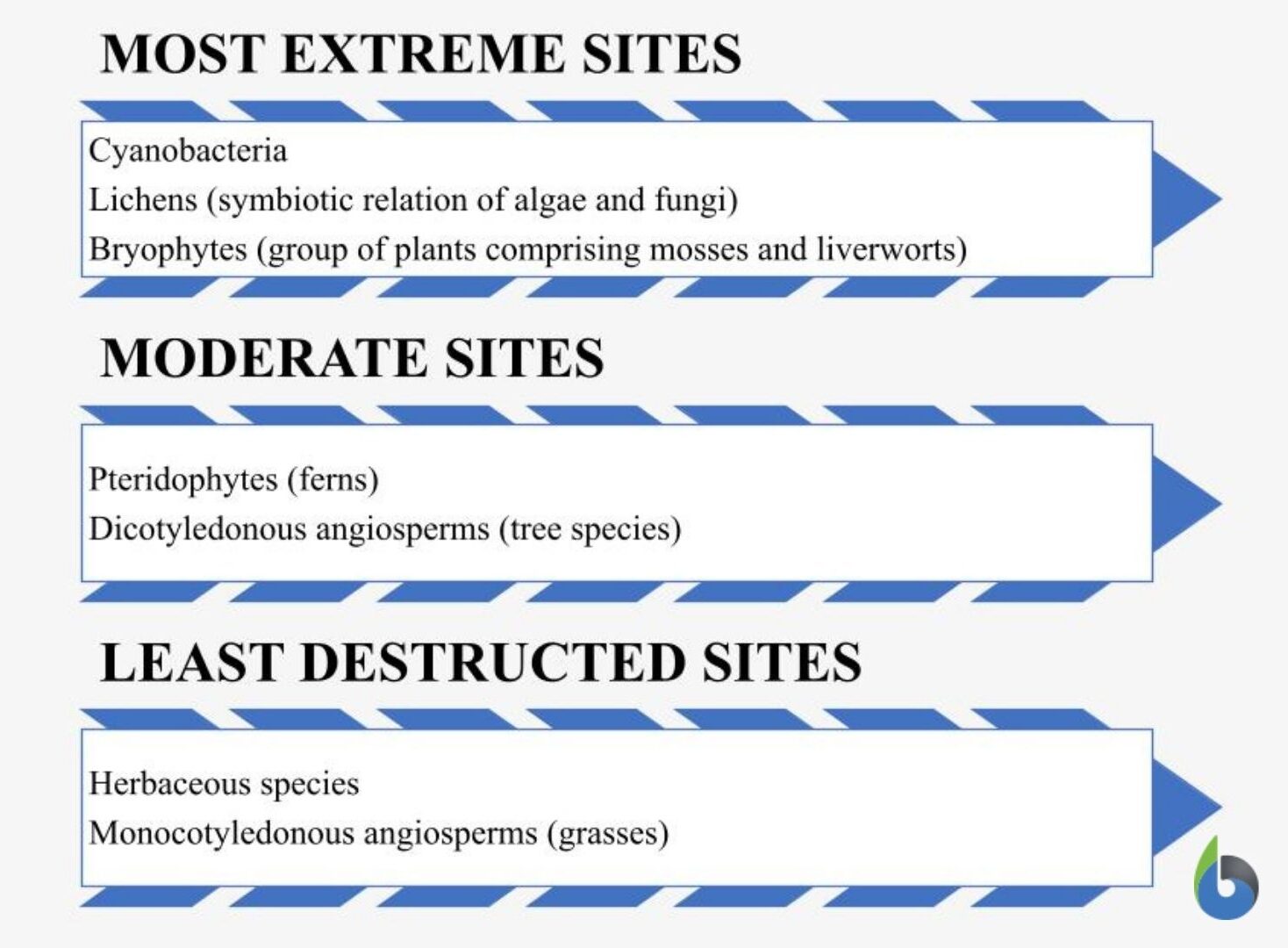
Secondary succession
In contrast to the barren and previously uninhabited areas, there are some areas that require re-establishment after a disturbance that “wiped out” a full-fledged ecological community. This re-establishment is the secondary succession. In these areas, some proportions of soil and previously occurring vegetation is remnant. These areas encounter fewer fights for resources and pioneer species here are more privileged. If asked what is a pioneer species in secondary succession, we can list out angiosperm trees and shrubs. These have some exceptionally high rates of growth and community development. Pioneer species in secondary succession don’t have to be photo-auto-litho-trophic out of compulsion.
Secondary succession examples:
Very recently microbial and species of invertebrate taxa have been included in the list of pioneer species. These species can be either photo/chemo, auto/hetero, litho/organo -trophs. This signifies a very important point here that secondary succession occurs in places where some sources of nutrients pre-exist in the substrate. Areas like deforested lands, forests that are logged, areas affected by windstorms, etc., are subject to secondary succession. So, many types of microbial species (bacteria, archaea), invertebrates, and tree species like Betula spp. (birch tree species) and Alnus spp. (Alder tree species) are examples of pioneer species causing secondary succession.
For more info on Primary and Secondary successions: Ecosystem Succession (Tutorial)
Pioneer Species Examples
We have made a comprehensive list of examples. Look at the picture below to know them. Only after pioneer flora and lichens are one with their jobs that pioneer bacteria, fungi, and fauna steps in. Examples of pioneer fauna are: soil invertebrates like ants, worms and snails, also some toads, etc.
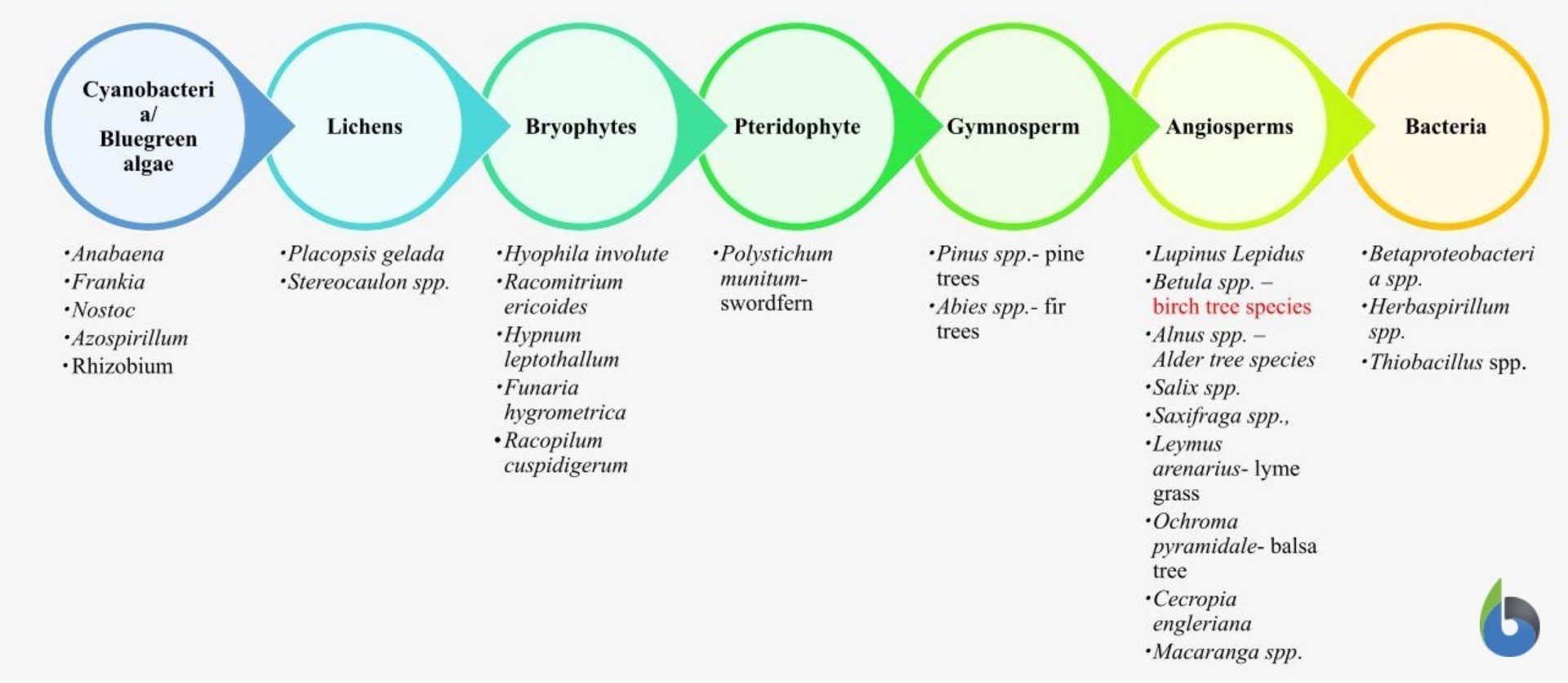
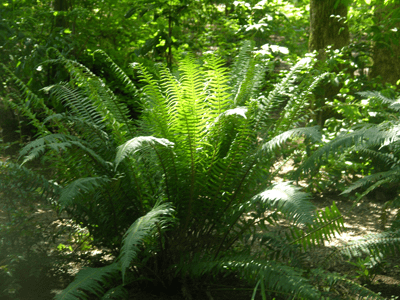
Interesting Fact

Did you know that the 1986 Nuclear Radiation Disaster of Chernobyl in Pripyat city of Soviet Union, which drew humans, animals, and other creatures out of the city gave birth to a new fungus that “feeds on radiation”? Yes… Scientists studying the area found “a pioneer fungus” that’s an extremophile adapted to high radiation and has an exceptional ability to eat it instead of being negatively affected by it (unlike other organisms). Like plants have phototropism (habit to be driven towards a light source), this fungal species is driven to the most extreme radioactive places. This quality is rendered to this species by its primary and secondary metabolic products which have surreal extreme-lytic and -enzymatic activity! Who knows how many more pioneer species have already been created in that disastrous site and not yet studied… and the creation of how many more pioneers will follow! Source: Ledford H. (2007), Dadachova E. (2007), Zhdanova NN (2004), Delbert (2020)
Try to answer the quiz below to check what you have learned so far about pioneer species.
References
1. Swaine, M.D., Whitmore, T.C. (1988) On the definition of ecological species groups in tropical rainforests. Vegetation 75, 81–86.
2. Grubb, P.J. (1986) The ecology of establishment. In: Bradshaw, A.D., Goode, D.A., Thorp, E. (Eds.), Symposium of the British Ecological Society, vol. 24: Ecology and Design in Landscape. Oxford: Blackwell, pp. 83–97.
3. Cao W., Xiong Y., Zhao D., Tan H., Qu J. (2020) Bryophytes and the symbiotic microorganisms, the pioneers of vegetation restoration in karst rocky desertification areas in southwestern China. Applied Microbiology and Biotechnology. 104(2): 873–891. doi: 10.1007/s00253-019-10235-0
4. Dalling JW. (2008) Pioneer Species. University of Illinois Urbana-Champaign, Urbana, IL, USA https://doi.org/10.1016/B978-0-444-63768-0.00534-5
5. Surtsey – Colonization of the land (2017) https://web.archive.org/web/20171117144204/http://www.surtsey.is/pp_ens/biola_3.htm
6. Ledford H. (2007) Hungry fungi chomp on radiation. Nature. doi:10.1038/news070521-5
7. Dadachova E., Bryan R., Huang X., Casadevall A. (2007) Ionizing Radiation Changes the Electronic Properties of Melanin and Enhances the Growth of Melanized Fungi. PLoS ONE 2(5): 457
8. Zhdanova NN, Tugay T, Dighton J, Zheltonozhsky V, McDermott P. (2004) Ionizing radiation attracts soil fungi. Mycol Res. 2004 Sep;108(9):1089-96. doi:10.1017/s0953756204000966
9. Delbert C. (2020) You Should Know About This Chernobyl Fungus That Eats Radiation. https://www.popularmechanics.com/science/a30784690/chernobyl-fungus/
©BiologyOnline.com. Content provided and moderated by Biology Online Editors.


